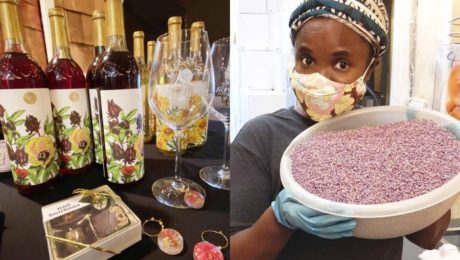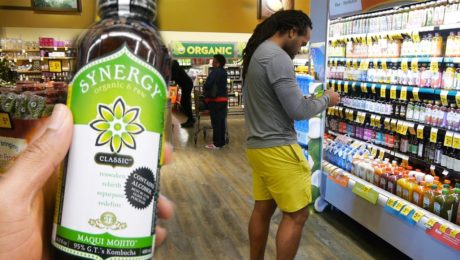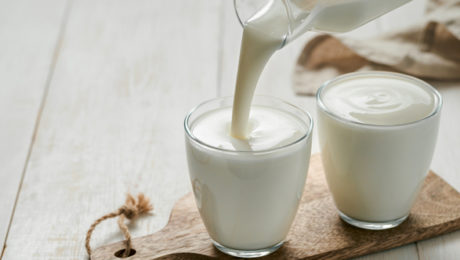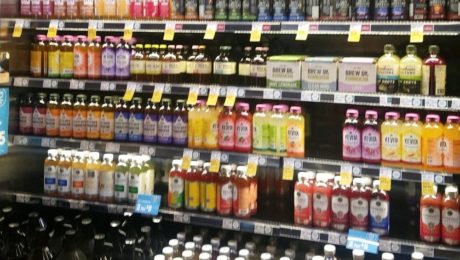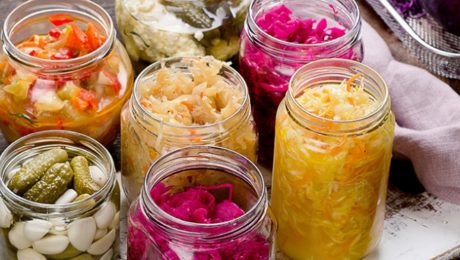South Carolina Classifies Kombucha as Alcoholic
Kombucha can no longer be legally sold as non-alcoholic in the state of South Carolina. A new rule change in state code set a maximum alcohol content for beers and other fermented beverages, but did not set a minimum alcohol level. Any fermented beverage with an alcohol content above 0.0% — any trace of alcohol — is now considered alcoholic by default.
Last month, TFA wrote about a decades-old South Carolina law that threatened kombucha and non-alcoholic beverage producers selling their fermented drinks in the state. Kombucha, which typically contains less than 0.5% alcohol [the legal definition of an alcoholic beverage in the U.S.], has always been deemed non-alcoholic, sold on grocery store shelves next to refrigerated juices.
Now, any brand selling a fermented beverage in the state must apply for an alcohol license, and their drink cannot be sold to anyone under the age of 21.
“Effective immediately, all of these producers and retailers will have to cease business until they receive the proper licensing, which will take several months to get if they’re located in South Carolina and the money to get their facilities up to code,” said Brook Bristow, an attorney specializing in beverage law, in a statement about the rule change. “So, until then, no sales, i.e., no money.”
Adds Gabriel Coggins, owner of the S.C.-based Kava Konnection:“Of all the things lawmakers could focus on to restrict and take away from the public, kombucha was the last thing I expected. It’s a healthy product, and the only logical reason I can see beyond some strange maliciousness toward it is that they just didn’t understand what they were doing.”
Read more (Greenville Journal)
- Published in Business
Are -Biotics Becoming a Diluted Claim?
More and more food and beverages are labeling their product with -biotics – probiotics, prebiotics and postbiotics — confusing consumers as to what a -biotic is and its potential health benefit.
There’s an “overuse of the term probiotic as referring to any live microbe,” says Bob Hutkins, professor of food microbiology and the University of Nebraska (and a Science Advisor on TFA’s Advisory Board). Probiotics, according to the International Scientific Association of Probiotics and Prebiotics (ISAPP), require documentation of both a health benefit and the strain.
“It’s a high bar to call something a probiotic,” he continues. “I read labels that say ‘contains probiotics’ and I’d say, the vast majority of the time, they’re incorrectly named if they’re named at all.”
Hutkins was part of a panel hosted by Food Navigator on “Feeding the Gut Microbiome: From Pre-, Pro-, and Postbiotics.” Speakers included leaders of food brands and -biotic supplement brands.
Is a Fermented Food Probiotic?
The issues surrounding probiotics and fermented foods have long been debated. TFA hosted a webinar on the topic in 2021, and it was the focus of a keynote session at TFA’s FERMENTATION 2021 conference.
Using the example of kimchi, Hutkins explains the fermented cabbage may contain live microbes that closely resemble a probiotic strain. But, according to scientific-backed definitions by ISAPP and the World Health Organization (WHO), “you can’t call that kimchi probiotic unless you isolated the strain, characterized the strain, done a clinical study and then that kimchi is going to be different from the kimchi you’ll make tomorrow. So it’s a challenge for companies that are producing fermented foods that probably have live microbes that can provide some benefits, but you can’t call them probiotics.”
Hutkins encourages fermentation producers to use the term “rich in live microbes” on their label instead. If the product does include clinically tested probiotics (like in yogurt), “I really applaud the company that puts the genus and species on their package.”
Consumer Education
Miguel Freitas, PhD, vice president of health scientific affairs at Danone North America, says the conversation in the industry needs to change from just probiotics to strain specificity.
“There are many consumers that are just seeking the word probiotic on the packaging. And they believe that probiotics will [help] everything from immune health to gut health,” Freitas says. “This is where I believe it can start to get tricky because there are so many products out there.”
Though the science around -biotics has evolved tremendously in the past two decades, consumers are overwhelmed and confused by all the choices.For example, he points to a new clothing brand that alleges the probiotics in their clothes are activated by heat.
This is why the food and beverage industry needs to play an active role in consumer education, says Todd Beckman, president of Verb Biotics.
“They have a platform to talk about health, these specific ingredients and health benefits,” he says. “They have the megaphone to talk to consumers in a true and authentic way.”
But Beckman warns: “the brands that don’t really know what they’re doing or don’t stand for anything or don’t stand for science, they’re not going to be there tomorrow.” Consumers will abandon brands with unsubstantiated health claims.
“If all of a sudden consumers aren’t believing in probiotics or what they can do, then it’s quite damaging,” he says.
Tom First, founder and CEO of Culture Pop probiotic soda, says that, though their brand has the clinical benefits of a verified and shelf-stable probiotic strain, they don’t lead with this complicated information in their marketing. Instead, they focus on flavor and it “being a fun drink,” figuring consumers can look to the Culture Pop website if they want to dive deeper.
Assorted -Biotics
Adding to consumer confusion: products on grocery shelves may now contain one of three -biotics – probiotics, prebiotics or postbiotics. Justin Green, PhD, director of scientific affairs at Cargill Health Technologies, says many think of -biotics as a daily supplement with a simple health benefit, like vitamin C.
“We really have to drive home there’s going to be different [-biotics] from different organisms, different fermentation techniques and most importantly different health benefits,” he says.
Probiotics are live bacteria; prebiotics are food for the bacteria; and postbiotics are metabolites produced by the probiotics.
An Overlooked Wine Category
“Aaliyah Nitoto, winemaker at Free Range Flower Winery, is tired of hearing that the category of wine is exclusive to grapes. For centuries, wine has been made from many kinds of plant products, she says, like grapes, apples, pears, rice and flowers,” reads an article in Wine Enthusiast.
The magazine highlights the history of flower wine, which has variations in the Middle East, Asia, Europe and even the U.S. The process to make the wine is different from a traditional grape wine. Fresh or dried flowers are boiled and crushed, then yeast and a sugar source are added to start the fermentation process.
Flower winemakers lament that their product is not respected in the wine industry. Flower wine has been made primarily by middle- to lower-income women.
“That can tell you right there why they were relegated to obscurity. The people who owned tracts of lands that had money and influence and got to name things like ‘noble grapes,’ they got to say what was wine and what wasn’t,” Nitoto (pictured) adds. “The opinion of people in this country over the last 100-odd years to try to get rid of this category doesn’t stand up to the history of winemaking, which is thousands of years old, which does call this wine.”
Read more (Wine Enthusiast)
- Published in Food & Flavor
Ukraine Cidery Destroyed by Russia
Berryland, an award-winning Ukranian cider and mead producer, was destroyed by a bomb in a Russian air raid. The employees escaped and were uninjured.
Owner and oenologist Vitalli Karvyha built his facility six years ago in the Makariv District of Kyiv. Karvyha makes his ciders and meads from local fruits and berries, and raised bees on site for the honey for his mead. His fermented beverages have earned him awards at Vintage Cider World in Germany and the Mazer Cup in Colorado.
Karvyha says he plans to rebuild, updating his status through Berryland Cidery’s Facebook page.
Read more (Broken Palate)
- Published in Business
Kombucha Sales Crawl
Two years after kombucha sales began to clock double-digit growth during the pandemic, sales are slowing, increasing only 1% over the last 52 weeks. But kombucha is still the sales leader in the fermented, non-alcoholic beverage space, representing nearly 85% of the category.
Kombucha pioneered the refrigerated functional beverage industry. For years it was one of the few beverages in the fermented, non-alcohol beverage space. But now there’s competition from new functional drinks — like prebiotic- and probiotic-infused sodas — that are diverting sales from kombucha.
“The consumer really is not OK with just drinking water. They want functionality out of everything they consume,” says Caroline Davidson, director of channel partnerships at SPINS (a data provider for natural, organic and specialty products). “Non-alcoholic beverages are traditionally not healthy options. To see that kombucha is actually one of the few segments contributing to double-digit growth (in that category), it’s really refreshing and encouraging.”
Those numbers were presented at KombuchaKon, the conference and trade show produced by Kombucha Brewers International (KBI). The event had been virtual the last two years, and brewers were anxious to meet in person again. Hundreds of brewers and brand leaders converged last week in Long Beach, Calif.
Here are highlights from SPINS’s kombucha market analysis.
Functional Beverages Grow
Refrigerated functional beverages are a top growth category across all sales channels — natural products stores, regional groceries and multi-outlet retailers (MULO) like WalMart, Target and CVS. Beverages made with -biotic cultures, high fiber sodas, water kefir sodas, drinking vinegars, kvass and tepache are all part of that growing category — and they compete with kombucha.
Shelf-stable functional beverages are growing even more quickly. For example, in the natural channel, sales of these drinks have increased nearly 25%, versus 4% for their refrigerated counterparts.
“It may not be refrigerated, but it still may be competition to a kombucha,” Davidson says.
Major Brands Diversify
Kombucha-adjacent products — like powdered kombucha and kombucha-flavored yogurt bites — are entering the market. So are kombuchas with no sugar or less than 1 gram of sugar.
“I am consistently seeing no sugar options in fermented beverages, which I know I’m speaking to an audience that already knows this, but fermentation doesn’t happen without sugar,” Davidson says. She notes more and more beverage categories “are seeing differentiation within probiotics of fermentation.”
Of the five fastest growing kombucha brands,— only two – Wild Tonic and Better Booch – are selling just traditional kombucha or hard kombucha. The other three – Humm, Health-Ade and Rowdy Mermaid – have added new product lines. Humm and Health-Ade sell prebiotic sodas and Rowdy Mermaid offers tonics.
Health-Ade is marketing their brand as a “gut health beverage” instead of simply kombucha. In a statement, Health-Ade CEO and co-founder Diana Trout says: “We have seen a dramatic increase in consumer interest in gut health over the past year as people begin to realize just how important gut health is to immunity and overall health. We wanted to offer our customers something that doesn’t compromise on taste and has legitimate gut health benefits, and (our new prebiotic drink) Pop does just that.”
Defining the Product
KBI has been well aware of changes in the category. Two years ago, it released the kombucha Code of Practice, the first set of safety and quality standards for the industry.
“Kombucha” is not a protected product name, unlike “tequila” or “champagne.” With the code, KBI aims to protect kombucha as a traditional fermented beverage. But KBI also doesn’t want to eliminate kombucha brands that may pasteurize and sell in shelf-stable cans, process from a base or brew with sweeteners.
Joshua Rood, CEO and managing director of Dr Hops hard kombucha, attended the SPINS presentation and thinks KBI “is standing in the right place.”
“First, we have to define what kombucha is. And then how you label variations of that, like if it’s filtered or pasteurized. Then you can actually have clarity and transparency for consumers so they actually know what they’re getting,” Rood says. “Right now, we don’t have that. It’s very rough, it’s essentially just an honor system.”
Rood emphasizes he has no problem with kombucha brands not brewing with traditional methods. But he says there needs to be a classification system and transparent labeling of how a kombucha is made. “There’s a lot of room for education,” he says.
Dr Hops, for example, prints a nutrition fact panel and calorie listing on their hard kombucha, even though most beer, wine and spirits are not legally required to do so.
“We try to be massively over-communicative on our labels,” Rood says. “And, if you’re looking at our labels from a calorie stance, it doesn’t look good because we have such high alcohol content. We’re not competitive in calories. But if we put it on there, people will learn that it’s 10% alcohol and most of the calories come from the alcohol.”
Shift in Retail Channels
Sales in natural stores – the retail channel that helped launch the kombucha industry have slowed, actually declining 5% over the past year. . But sales over the same period grew 3% in MULO outlets and 2% at convenience stores.
“People are still trying to find outlets where they can get everything in one trip,” Davidson says. “We’re seeing a lot more consolidation of what people are purchasing in one trip or fewer trips per month.”
Hard Kombucha “Massively Outperforming”
SPINS’s “flavored malt beverages” category includes a number of alcoholic drinks that don’t contain malt. While hard seltzers have long dominated here, six of the 10 fastest-growing brands in natural retailers are now hard kombucha brands: Boochcraft, Flying Embers, June Shine, Kyla, Strange Beast and Nova Easy.
“Natural retailers are fully embracing this as a new category and it’s paying off exponentially,” Davidson says.
Hard kombucha sales are still small overall, at $58.31 million, are driving growth in the category and “massively outperforming hard cider,” Davidson says. Dollar growth for hard kombucha is almost 60%, while sales of hard cider are declining. Sales for the hard seltzer – including category leaders White Claw and Truly – are also slipping in all retail channels.
- Published in Business
The Trending Nordic Diet
For nearly two decades, the Mediterranean diet has been the food choice recommended by dietitians and the USDA.. This approach to eating has been proven to improve health and reduce risk of chronic disease.
But there’s a new contender: the Nordic diet.
This plan focuses on eating fermented foods and beverages, with less meat and more legumes than in the Mediterranean diet. Both approaches are plant-based and full of lean proteins, complex carbs and healthy fats.
“The nordic diet really does promote a lifelong approach to healthy eating,” says Valerie Agyeman, RDN (pictured). “It also really really focuses on seasonal, local, organic and sustainably sourced whole foods that are traditionally eaten in the Nordic region.”
Agyeman, founder of Flourish Heights, shared her research during a Today’s Dietitian webinar “Breaking Down the Nordic Diet: Why is it Gaining So Much Popularity?” The presentation was designed to help registered dietitians better counsel clients on healthy eating habits.
What is Nordic Eating?
The diet embraces traditional Nordic cuisine, with a focus on ingredients that are fresh and local. The core of the fare is from Sweden, Norway, Denmark, Finland and Iceland.
“Fresh, pure and earthly are the words used to describe this food movement that was born out of the landscape and culture,” Agyeman says. “The Nordic movement is all about using what is available.”
The goal is not to invent a new cuisine, but to get back to its roots. Seafood is central, but meat – scarce during the long Nordic winters – is treated as a side dish Fresh vegetables and berries – the most common Nordic fruit – are prevalent during the summer. Fermented foods were born out of the necessity to preserve food from the warmer months to eat during winter. The indigenous Nordic people traditionally fermented vegetables, fish and dairy.
“It really takes the focus off calories and puts it on healthy food,” Agyeman adds. “This way of eating is pretty nutrient-dense.”
Nordic foods, she continues, are served in their natural state with minimal processing. They’re high in antioxidants, prebiotics, probiotics, fiber, minerals and vitamins; low in saturated fats, trans fats, added sugars and added salts.
“The Nordic diet is really not that straightforward,” Agyeman says. “When you think of other cuisines, like Italian cuisine, they have signature flavors and various culinary techniques that make up Italian cuisine. When it comes to Nordic cooking, it’s very diverse.”
Sustainability
Key, too, is sustainability. Foods from the Nordic countries have a lower environmental impact because they’re sourced locally and eaten in season.
Sustainability is also partly why Nordic cuisine has become a staple at many restaurants. The farm-to-table style continues to expand in restaurant dining, along with fermentation. Restaurants around the world are following the lead of Copenhagen’s Noma and building their own labs to explore the flavors and textures fermentation adds to dishes.
“Today [fermentation] is not something that’s needed,” like it was before a global food scene made it simpler to eat fresh food year round, Agyeman says. “But culinary wise, fermentation has evolved. It’s become a big part of these new creations.”
Fermented foods and beverages add to the “epicurean experience,” adds Dr. Luiza Petre, a cardiologist and nutrition expert based in New York.
“Savory flavors and fermented food with spices make it a culinary experience,” she says.
Health Benefits
Studies show eating the Nordic diet prevents obesity and reduces the risk of cardiovascular disease, type 2 diabetes, high blood pressure and high cholesterol.
The health effects of the Nordic diet were always assumed to be solely due to weight loss. But results of the most recent study of the diet, published in the journal Clinical Nutrition in February, found the positive health effects are “irrespective of weight loss.”
“It’s surprising because most people believe that positive effects on blood sugar and cholesterol are solely due to weight loss. Here, we have found this not to be the case. Other mechanisms are also at play,” said Lars Ove Dragsted, of the University of Copenhagen’s Department of Nutrition, Exercise and Sports in a statement on the study.
The researchers from Denmark, Finland, Norway, Sweden and Iceland studied 200 people over 50 years of age with elevated BMI. All were at an increased risk of diabetes and cardiovascular disease. For six months, the group ate the Nordic diet while a control group ate their regular meals.
“The group that had been on the Nordic diet for six months became significantly healthier, with lower cholesterol levels, lower overall levels of both saturated and unsaturated fat in the blood, and better regulation of glucose, compared to the control group,” Dragsted said. “We kept the group on the Nordic diet weight stable, meaning that we asked them to eat more if they lost weight. Even without weight loss, we could see an improvement in their health.”
- Published in Health
Raising Capital in 2022
While tempting for a food or beverage producer to take money from any investor offering money, companies should instead seek one with industry experience.
“Think of your investment partner as a business partner. Who do you want to continue to build your company with?” says Ashleigh Lockerbie, co-founder and CMO of Better Booch kombucha (pictured). While it’s great to find an investor who simply wants to write checks, she advises looking for someone with industry knowledge and networking contacts. “There’s a value that goes beyond money with that kind of experience.”
Lockerbie spoke on raising capital during a panel at Natural Products Expo West. She was joined by Bob Nakasone, managing director of private equity firm First Beverage Ventures (and acting CSO of Health-Ade Kombucha), and Robert Parzick, managing director of food- and beverage-focused capital advisory firm Cody Peak.
After a pandemic-induced lull in 2020, last year saw a capital raising boom, with venture capitalists investing over $300 billion. The number of deals in 2021 was up only 10% from 2020, but their dollar total was roughly two times higher.
“That’s a big trend from the investment standpoint,” Nakasone says. “It speaks to the level of competitiveness out there and the capital required to break through.”
What the capital raising environment in 2022 will produce is unknown. With supply chain challenges, rising material costs and labor shortages affecting every food and beverage producer, it’s become more expensive to do business. Here are some of the attributes investors are looking for in a deal.
Skilled Founder and Management Team
When considering an investment, Nakasone says they want a company with a proficient founder. Or, if a founder doesn’t have management experience, there needs to be someone in the company who does. This expertise is needed to support the business as it grows.
“The management team is valued far more now than 10 years ago,” Nakasone says. It used to be assumed an investor would take on a management role, but investors now want the brand to have that skill set. “A lot of businesses they’re buying are for their capabilities. They may be buying a kombucha company for example for broader fermentation capabilities that they don’t have today.”
Lockerbie pointed out that Better Booch has structured their advisory board with three members with different backgrounds — one in finance, another in marketing and the third with CPG experience.
“Raising money is a full time job, and when you’re a founder, you have 10 full time jobs,” she says. “I think anytime you can outsource to someone who knows more about the subject than you do is always a plus.”
Profitability Over Growth
Many startups weigh focusing on the company’s short-term profitability versus sales growth. Capital raising has long valued growth, but that’s changed in the last few years, Parzick says.
“Four to five years ago, everybody was hell bent on growth, but nobody cared about profitability. Now everybody cares about profitability,” he says. “The first question we get, almost more important than what the growth trajectory is, is ‘Are they profitable?’ Or ‘Will they be profitable?’”
Parzick advises companies to come to an investor with a 2-3 year budget. And, importantly, don’t wait to start raising money until you’re almost out of it, he said.
Adds Nakasone: “My favorite introductions are when entrepreneurs do not need money. It’s a less pressured conversation; there’s not a ticking clock, so to speak.”
Diverse Portfolio
Companies are breaking out of specific categories, especially in the beverage space. Nakasone said major non-alcoholic beverage companies are, for the first time, breaking into the alcoholic beverage space, and vice versa.
“They feel the need to be total beverage companies,” he says.
Coffee, too, is trending. More beverage brands are adding coffee lines or coffee-flavored drinks (for example, Better Booch released a coffee-flavored kombucha at Expo West).
“Coffee is continuing to be an outstanding category with a lot of growth and innovation and so it’s ripe for entrepreneurs to enter,” Nakasone added.
Parzick says investors look at the range of a company’s retail locations, too. He points out that many startups “built their businesses on the back of Trader Joe’s or Wal-Mart or Costco.”
“Most growing companies have a fair amount [of] customer concentration,” Parzick says. “But in a perfect world…you’d like to be hopefully well below 50% with one customer.”
- Published in Business
Fermented Dairy Improves Memory
A new study found fermented dairy products reduce memory loss. The study, published in Nutritional Neurosciences, confirms there is a connection between the gut microbiome and the nervous system, known as the gut-brain axis
The adults in the test regularly consumed a dairy-based fermented drink, containing 25-30 billion colony forming units (CFUs). Drinking fermented dairy — like yogurt, kefir or fermented whey — “increased the presence of certain microorganisms in the gut and improved relational memory in healthy adults.”
Read more (Nutritional Neurosciences)
Could Outdated Law Force Fermented Drinks Off Shelves?
A decades-old South Carolina law is threatening kombucha and non-alcoholic beverage producers who sell their fermented drinks in the state.
The current statute dictates that a permit is needed to sell beer and other fermented beverages. But the law lists no minimum ABV, forcing kombucha brewers and non-alcoholic beer producers to follow the same permitting regulations as alcoholic brands.
Though the statute is loosely enforced, it came to a head recently (pun intended). Non-alcohol beer company Athletic Brewing Co. announced it would no longer sell their products in South Carolina due to ““the recent legal interpretation by state officials on the unique definition of non-alcoholic beer.” The state’s Department of Revenue began investigating Athletic Brewing Co. after receiving a complaint about the brewer.
“This is definitely going to create a lot of uncertainty for a lot of different types of businesses and, you know, ultimately, the question is, ‘Are we going to apply the alcohol rules to companies who don’t necessarily, you know, the alcohol is so minimal?’” said Brook Bristow, an attorney at Bristow Beverage Law, who served as Executive Director of the state’s Brewers Guild for seven years.
Brewers that want to comply with the current law have to apply for an expensive license. SouthCarolina’s General Assembly currently has no bills under discussion that would modify the regulations.
Read more (The Free Times)
- Published in Business
Survey: Fermented Foods and Consumer Behavior
A new study aims to profile consumer habits with fermented foods and beverages. Researchers want to know the types of fermented products that are most popular — and why. To TFA’s knowledge, this is the first major study probing consumer perceptions of fermented foods.
“With this survey we hope to gain a better understanding of the types of fermented foods people are consuming and what motivates them to incorporate fermented foods into their diet,” says Erin DiCaprio, PhD, a food safety expert and extension specialist at UC Davis. “We also want to gather data on the trends related to in-home fermentation and the sources of information the public turns to related to fermented foods. The data we collect will help inform future areas of focus for research and education on fermented foods.”
The study is conducted by the EATLAC project at the University of California, Davis, Department of Food Science and Technology. EATLAC (Evaluating And Testing Lacto-ferments Across the Country), funded by California’s agricultural department, aims to provide accurate information and resources to the public. EATLAC’s directors are DiCaprio and Maria Marco, PhD, microbiologist and professor in the department of food science and technology at the university (and member of TFA’s Advisory Board).
To participate in the 10-minute anonymous survey, follow the link: https://ucdavis.co1.qualtrics.com/jfe/form/SV_0CzKfHUWgX2HHVj
- Published in Food & Flavor, Science



